The Role, Barriers, and Benefits: Third Sector Organisations Report
VerifiedAdded on 2021/02/19
|7
|1869
|92
Report
AI Summary
This report provides a comprehensive analysis of third-sector organizations, focusing on their roles, benefits, and the barriers they face within the context of public services. It begins with an introduction to the concept of third-sector organizations, defining their characteristics and objectives, and uses Oxfam as a case study. The report then delves into the specific roles these organizations play, including their contributions to social welfare and community development, and the various levels at which they operate. A key section compares and analyzes the challenges, such as financial constraints and human resource limitations, and the advantages these organizations bring, including increased standards of living and the provision of essential services. The report also justifies the importance of third-sector organizations in supplementing and enhancing the work of public services, emphasizing their non-profit nature and their ability to address societal needs. The conclusion summarizes the key findings, reinforcing the significant impact of third-sector organizations on societal growth and the delivery of public services.
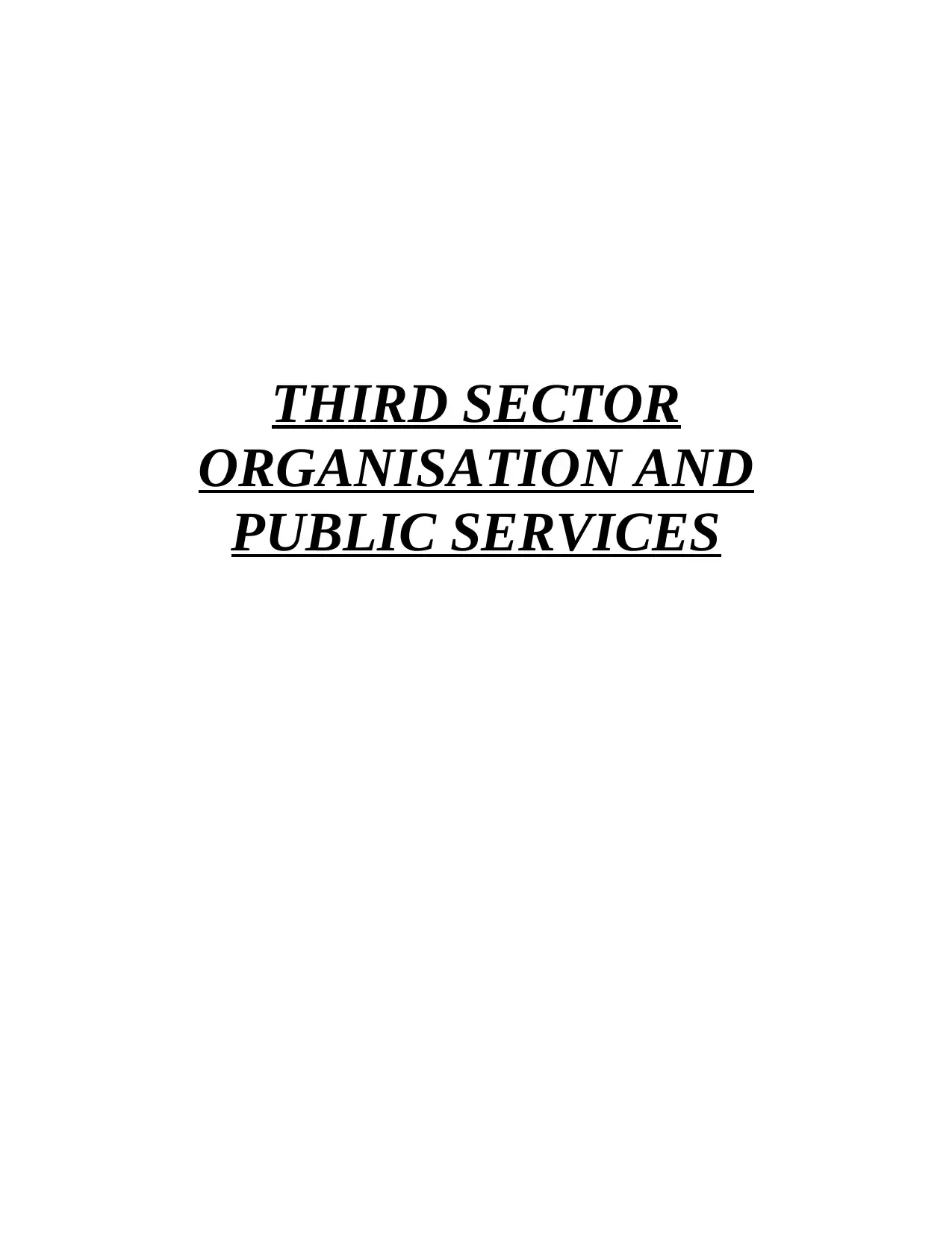
THIRD SECTOR
ORGANISATION AND
PUBLIC SERVICES
ORGANISATION AND
PUBLIC SERVICES
Paraphrase This Document
Need a fresh take? Get an instant paraphrase of this document with our AI Paraphraser
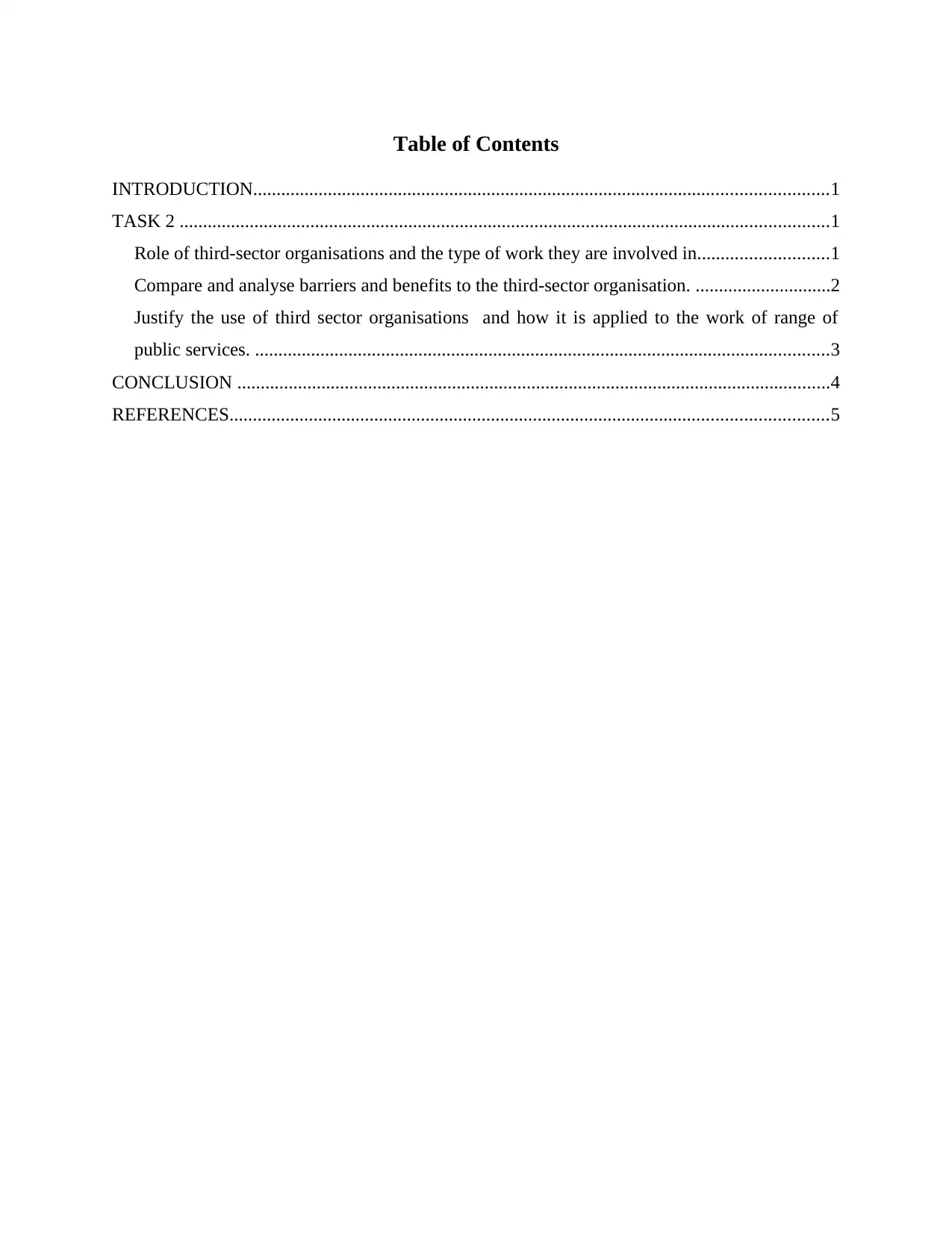
Table of Contents
INTRODUCTION...........................................................................................................................1
TASK 2 ...........................................................................................................................................1
Role of third-sector organisations and the type of work they are involved in............................1
Compare and analyse barriers and benefits to the third-sector organisation. .............................2
Justify the use of third sector organisations and how it is applied to the work of range of
public services. ...........................................................................................................................3
CONCLUSION ...............................................................................................................................4
REFERENCES................................................................................................................................5
INTRODUCTION...........................................................................................................................1
TASK 2 ...........................................................................................................................................1
Role of third-sector organisations and the type of work they are involved in............................1
Compare and analyse barriers and benefits to the third-sector organisation. .............................2
Justify the use of third sector organisations and how it is applied to the work of range of
public services. ...........................................................................................................................3
CONCLUSION ...............................................................................................................................4
REFERENCES................................................................................................................................5
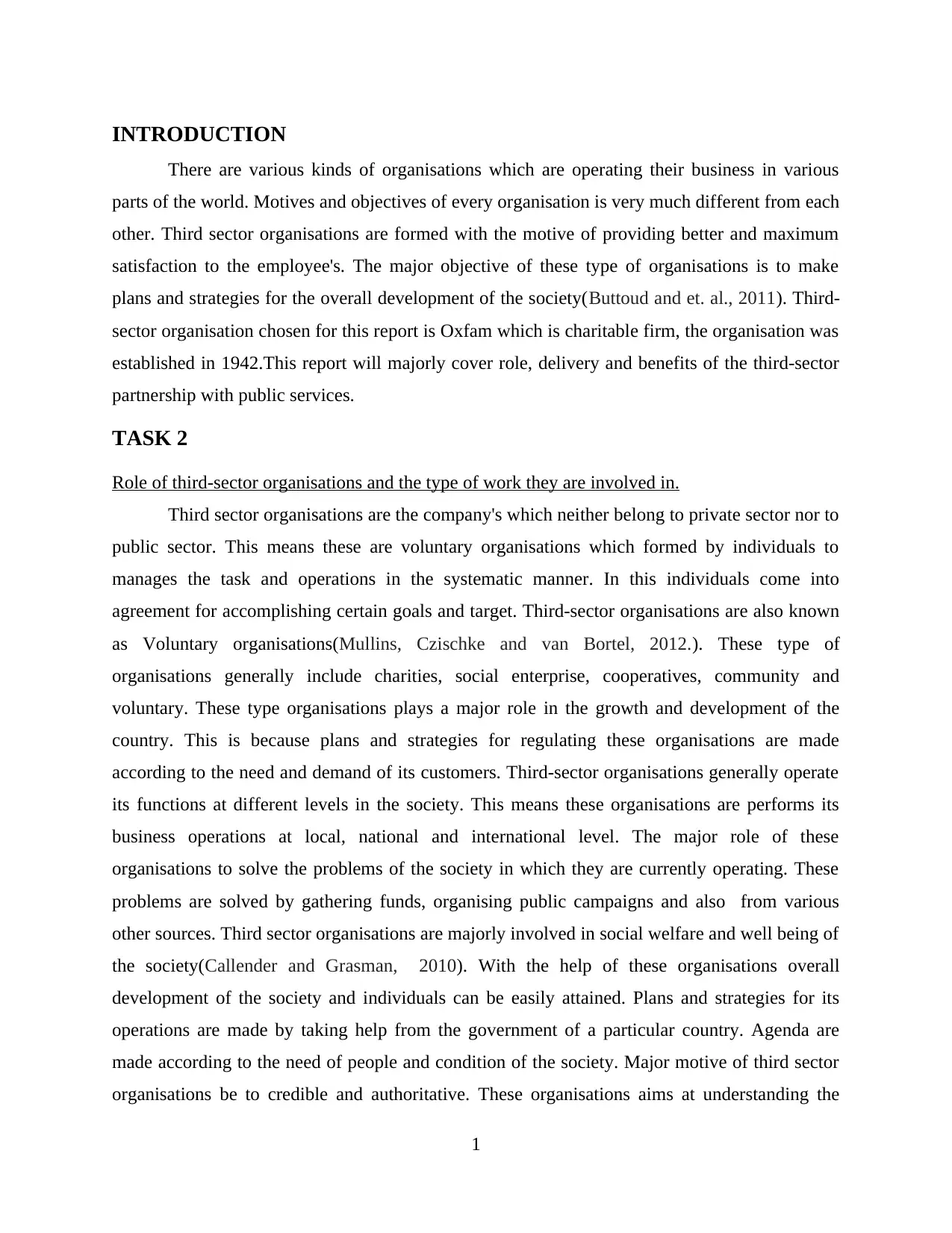
INTRODUCTION
There are various kinds of organisations which are operating their business in various
parts of the world. Motives and objectives of every organisation is very much different from each
other. Third sector organisations are formed with the motive of providing better and maximum
satisfaction to the employee's. The major objective of these type of organisations is to make
plans and strategies for the overall development of the society(Buttoud and et. al., 2011). Third-
sector organisation chosen for this report is Oxfam which is charitable firm, the organisation was
established in 1942.This report will majorly cover role, delivery and benefits of the third-sector
partnership with public services.
TASK 2
Role of third-sector organisations and the type of work they are involved in.
Third sector organisations are the company's which neither belong to private sector nor to
public sector. This means these are voluntary organisations which formed by individuals to
manages the task and operations in the systematic manner. In this individuals come into
agreement for accomplishing certain goals and target. Third-sector organisations are also known
as Voluntary organisations(Mullins, Czischke and van Bortel, 2012.). These type of
organisations generally include charities, social enterprise, cooperatives, community and
voluntary. These type organisations plays a major role in the growth and development of the
country. This is because plans and strategies for regulating these organisations are made
according to the need and demand of its customers. Third-sector organisations generally operate
its functions at different levels in the society. This means these organisations are performs its
business operations at local, national and international level. The major role of these
organisations to solve the problems of the society in which they are currently operating. These
problems are solved by gathering funds, organising public campaigns and also from various
other sources. Third sector organisations are majorly involved in social welfare and well being of
the society(Callender and Grasman, 2010). With the help of these organisations overall
development of the society and individuals can be easily attained. Plans and strategies for its
operations are made by taking help from the government of a particular country. Agenda are
made according to the need of people and condition of the society. Major motive of third sector
organisations be to credible and authoritative. These organisations aims at understanding the
1
There are various kinds of organisations which are operating their business in various
parts of the world. Motives and objectives of every organisation is very much different from each
other. Third sector organisations are formed with the motive of providing better and maximum
satisfaction to the employee's. The major objective of these type of organisations is to make
plans and strategies for the overall development of the society(Buttoud and et. al., 2011). Third-
sector organisation chosen for this report is Oxfam which is charitable firm, the organisation was
established in 1942.This report will majorly cover role, delivery and benefits of the third-sector
partnership with public services.
TASK 2
Role of third-sector organisations and the type of work they are involved in.
Third sector organisations are the company's which neither belong to private sector nor to
public sector. This means these are voluntary organisations which formed by individuals to
manages the task and operations in the systematic manner. In this individuals come into
agreement for accomplishing certain goals and target. Third-sector organisations are also known
as Voluntary organisations(Mullins, Czischke and van Bortel, 2012.). These type of
organisations generally include charities, social enterprise, cooperatives, community and
voluntary. These type organisations plays a major role in the growth and development of the
country. This is because plans and strategies for regulating these organisations are made
according to the need and demand of its customers. Third-sector organisations generally operate
its functions at different levels in the society. This means these organisations are performs its
business operations at local, national and international level. The major role of these
organisations to solve the problems of the society in which they are currently operating. These
problems are solved by gathering funds, organising public campaigns and also from various
other sources. Third sector organisations are majorly involved in social welfare and well being of
the society(Callender and Grasman, 2010). With the help of these organisations overall
development of the society and individuals can be easily attained. Plans and strategies for its
operations are made by taking help from the government of a particular country. Agenda are
made according to the need of people and condition of the society. Major motive of third sector
organisations be to credible and authoritative. These organisations aims at understanding the
1
⊘ This is a preview!⊘
Do you want full access?
Subscribe today to unlock all pages.

Trusted by 1+ million students worldwide

need of customers, it has the ability and capability to deliver proper outcomes to the local public,
provides innovation in various situations. Third sector organisations also plays a major role
within the society in which they are operating its business. This is because these organisations
aims at providing better satisfaction to its is employees. With the help of these organisations
chances of poverty and other problems can be easily reduced. Various kinds of services are
offered to individuals in the society. These include- food, shelter, clothing, etc. Oxfam is the
third sector organisation which was majorly established to remove and reduce the chances of
poverty from the society from various parts of the world. Oxfam aims at providing sustainable
livelihoods to the society, it ensures that individuals have right for the their safety and security.
Oxfam works for removing poverty by taking appropriate actions with the help of government of
a particular government(Lawrie and Cobbold, 2004).
Compare and analyse barriers and benefits to the third-sector organisation.
There are various kinds of barriers and problems faced by third-sector organisations in
the society. These problems directly result in inappropriate functioning of the organisation. This
is because it becomes difficult for such organisations to operate its business in uncertain business
environment. The major type of barriers include- financial, governance, external relation
barriers,etc. Third-sector organisations generally do not get appropriate funds form the society in
which they are operating. Due to inadequacy of fund these organisations are not able to provide
maximum satisfaction to the needy people. These type of organisations have proper availability
of fund and due to this is becomes difficult for them to sustain in the market for longer period of
time. Another kind of barrier which is faced by third-sector organisations is inadequacy of
human resource. These type of organisations have very less employees and due to this they are
unable to provide better satisfaction to the society. Management of the organisation also face
many kind of difficulty in recruiting and hiring skilled employee's. There are various kinds of
benefits to public services through outsourcing. One of the major benefit of these organisations is
it helps in increasing standard of living of the individuals of the society. Better services are
offered to the needy individuals, this directly lead to increase in their standard of living. Another
benefit of these type of organisations is it helps in providing basic amenities to the individuals in
a systematic manner(Moulaert and Ailenei, 2015). These type of amenities include food, shelter,
clothing, etc. individuals also get various opportunities for employment. With the help of
employment opportunities their standard of living is automatically improved. Third-sector
2
provides innovation in various situations. Third sector organisations also plays a major role
within the society in which they are operating its business. This is because these organisations
aims at providing better satisfaction to its is employees. With the help of these organisations
chances of poverty and other problems can be easily reduced. Various kinds of services are
offered to individuals in the society. These include- food, shelter, clothing, etc. Oxfam is the
third sector organisation which was majorly established to remove and reduce the chances of
poverty from the society from various parts of the world. Oxfam aims at providing sustainable
livelihoods to the society, it ensures that individuals have right for the their safety and security.
Oxfam works for removing poverty by taking appropriate actions with the help of government of
a particular government(Lawrie and Cobbold, 2004).
Compare and analyse barriers and benefits to the third-sector organisation.
There are various kinds of barriers and problems faced by third-sector organisations in
the society. These problems directly result in inappropriate functioning of the organisation. This
is because it becomes difficult for such organisations to operate its business in uncertain business
environment. The major type of barriers include- financial, governance, external relation
barriers,etc. Third-sector organisations generally do not get appropriate funds form the society in
which they are operating. Due to inadequacy of fund these organisations are not able to provide
maximum satisfaction to the needy people. These type of organisations have proper availability
of fund and due to this is becomes difficult for them to sustain in the market for longer period of
time. Another kind of barrier which is faced by third-sector organisations is inadequacy of
human resource. These type of organisations have very less employees and due to this they are
unable to provide better satisfaction to the society. Management of the organisation also face
many kind of difficulty in recruiting and hiring skilled employee's. There are various kinds of
benefits to public services through outsourcing. One of the major benefit of these organisations is
it helps in increasing standard of living of the individuals of the society. Better services are
offered to the needy individuals, this directly lead to increase in their standard of living. Another
benefit of these type of organisations is it helps in providing basic amenities to the individuals in
a systematic manner(Moulaert and Ailenei, 2015). These type of amenities include food, shelter,
clothing, etc. individuals also get various opportunities for employment. With the help of
employment opportunities their standard of living is automatically improved. Third-sector
2
Paraphrase This Document
Need a fresh take? Get an instant paraphrase of this document with our AI Paraphraser
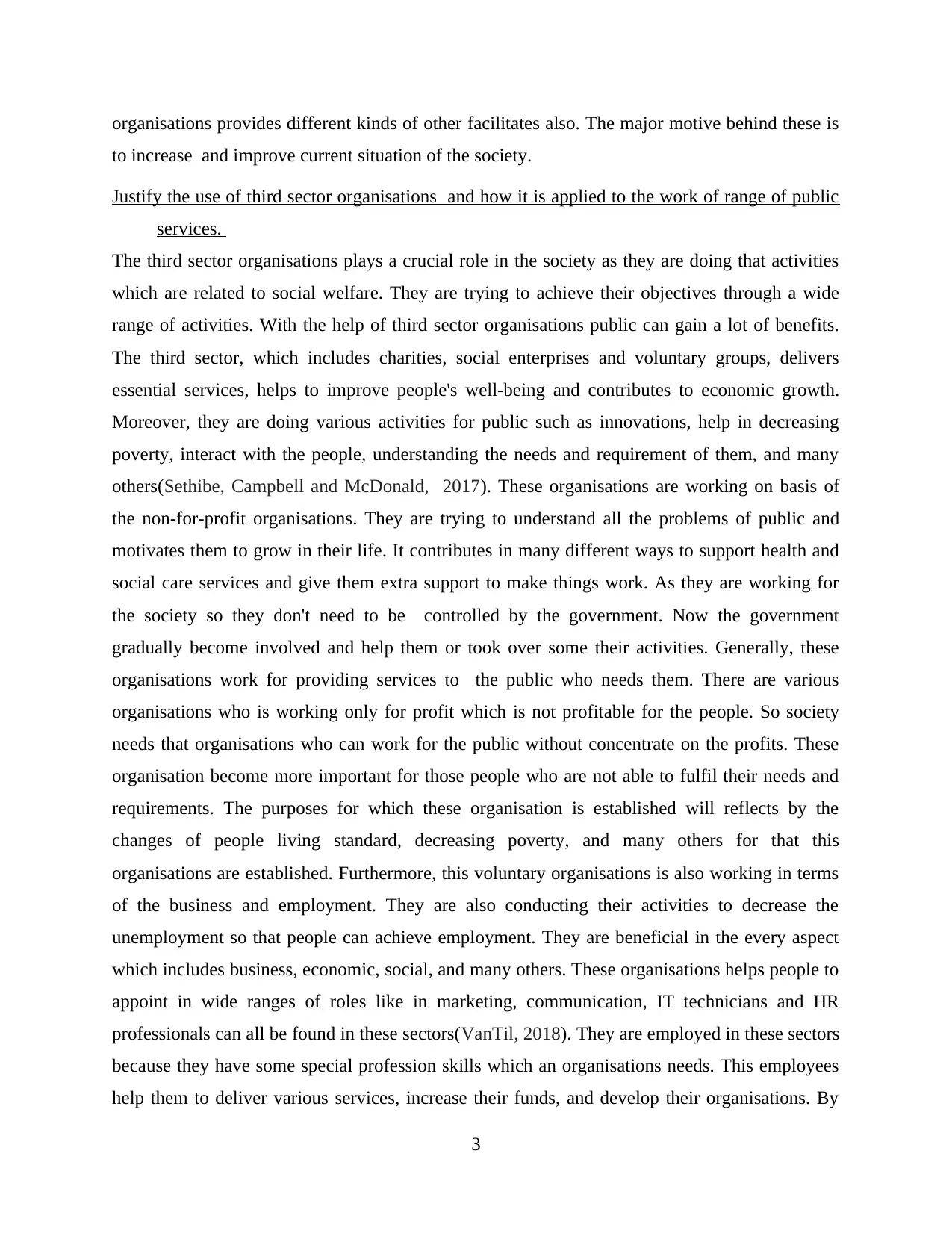
organisations provides different kinds of other facilitates also. The major motive behind these is
to increase and improve current situation of the society.
Justify the use of third sector organisations and how it is applied to the work of range of public
services.
The third sector organisations plays a crucial role in the society as they are doing that activities
which are related to social welfare. They are trying to achieve their objectives through a wide
range of activities. With the help of third sector organisations public can gain a lot of benefits.
The third sector, which includes charities, social enterprises and voluntary groups, delivers
essential services, helps to improve people's well-being and contributes to economic growth.
Moreover, they are doing various activities for public such as innovations, help in decreasing
poverty, interact with the people, understanding the needs and requirement of them, and many
others(Sethibe, Campbell and McDonald, 2017). These organisations are working on basis of
the non-for-profit organisations. They are trying to understand all the problems of public and
motivates them to grow in their life. It contributes in many different ways to support health and
social care services and give them extra support to make things work. As they are working for
the society so they don't need to be controlled by the government. Now the government
gradually become involved and help them or took over some their activities. Generally, these
organisations work for providing services to the public who needs them. There are various
organisations who is working only for profit which is not profitable for the people. So society
needs that organisations who can work for the public without concentrate on the profits. These
organisation become more important for those people who are not able to fulfil their needs and
requirements. The purposes for which these organisation is established will reflects by the
changes of people living standard, decreasing poverty, and many others for that this
organisations are established. Furthermore, this voluntary organisations is also working in terms
of the business and employment. They are also conducting their activities to decrease the
unemployment so that people can achieve employment. They are beneficial in the every aspect
which includes business, economic, social, and many others. These organisations helps people to
appoint in wide ranges of roles like in marketing, communication, IT technicians and HR
professionals can all be found in these sectors(VanTil, 2018). They are employed in these sectors
because they have some special profession skills which an organisations needs. This employees
help them to deliver various services, increase their funds, and develop their organisations. By
3
to increase and improve current situation of the society.
Justify the use of third sector organisations and how it is applied to the work of range of public
services.
The third sector organisations plays a crucial role in the society as they are doing that activities
which are related to social welfare. They are trying to achieve their objectives through a wide
range of activities. With the help of third sector organisations public can gain a lot of benefits.
The third sector, which includes charities, social enterprises and voluntary groups, delivers
essential services, helps to improve people's well-being and contributes to economic growth.
Moreover, they are doing various activities for public such as innovations, help in decreasing
poverty, interact with the people, understanding the needs and requirement of them, and many
others(Sethibe, Campbell and McDonald, 2017). These organisations are working on basis of
the non-for-profit organisations. They are trying to understand all the problems of public and
motivates them to grow in their life. It contributes in many different ways to support health and
social care services and give them extra support to make things work. As they are working for
the society so they don't need to be controlled by the government. Now the government
gradually become involved and help them or took over some their activities. Generally, these
organisations work for providing services to the public who needs them. There are various
organisations who is working only for profit which is not profitable for the people. So society
needs that organisations who can work for the public without concentrate on the profits. These
organisation become more important for those people who are not able to fulfil their needs and
requirements. The purposes for which these organisation is established will reflects by the
changes of people living standard, decreasing poverty, and many others for that this
organisations are established. Furthermore, this voluntary organisations is also working in terms
of the business and employment. They are also conducting their activities to decrease the
unemployment so that people can achieve employment. They are beneficial in the every aspect
which includes business, economic, social, and many others. These organisations helps people to
appoint in wide ranges of roles like in marketing, communication, IT technicians and HR
professionals can all be found in these sectors(VanTil, 2018). They are employed in these sectors
because they have some special profession skills which an organisations needs. This employees
help them to deliver various services, increase their funds, and develop their organisations. By
3

giving the employment opportunities to the people they can increase their growth in every
aspect. These all the activities which is doing by third sector organisations helps to develop the
society in better manner. Government is also motivates and helps Third sector organisations so
that they can achieve their targets and goals easily.
CONCLUSION
From the above given report it has been concluded that third-sector organisations plays a
major role in the overall growth and development of the society. Plans and strategies can be
made for providing better satisfaction to its customers and needy people. There various kind of
barriers and obstacles which are faced by the these type of organisations. Along with the barriers
these organisations also have different kinds of benefits. These benefits directly lead to increase
in productivity and performance of the organisation. These type of organisations are also useful
for providing wide range of public services in the best possible manner.
4
aspect. These all the activities which is doing by third sector organisations helps to develop the
society in better manner. Government is also motivates and helps Third sector organisations so
that they can achieve their targets and goals easily.
CONCLUSION
From the above given report it has been concluded that third-sector organisations plays a
major role in the overall growth and development of the society. Plans and strategies can be
made for providing better satisfaction to its customers and needy people. There various kind of
barriers and obstacles which are faced by the these type of organisations. Along with the barriers
these organisations also have different kinds of benefits. These benefits directly lead to increase
in productivity and performance of the organisation. These type of organisations are also useful
for providing wide range of public services in the best possible manner.
4
⊘ This is a preview!⊘
Do you want full access?
Subscribe today to unlock all pages.

Trusted by 1+ million students worldwide
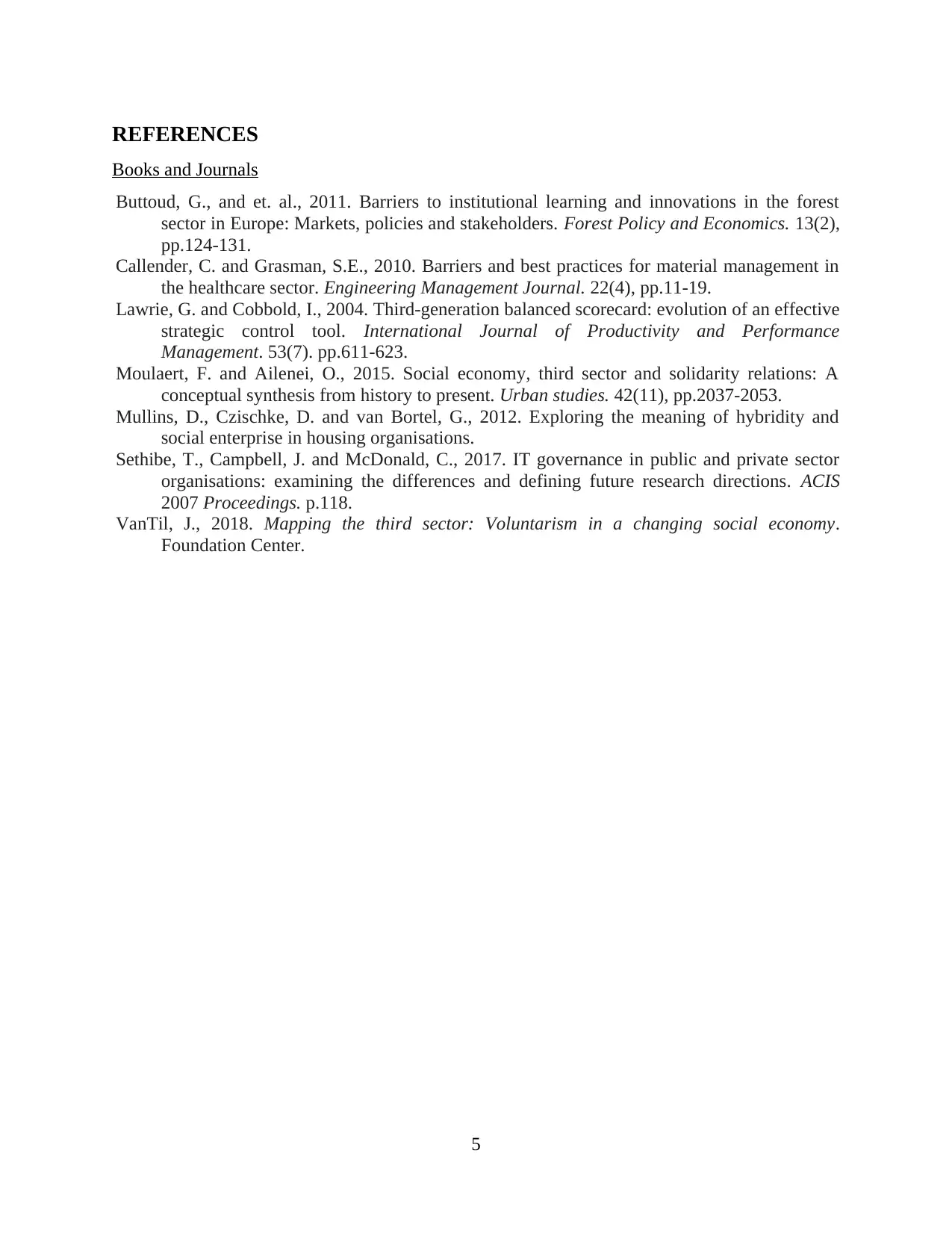
REFERENCES
Books and Journals
Buttoud, G., and et. al., 2011. Barriers to institutional learning and innovations in the forest
sector in Europe: Markets, policies and stakeholders. Forest Policy and Economics. 13(2),
pp.124-131.
Callender, C. and Grasman, S.E., 2010. Barriers and best practices for material management in
the healthcare sector. Engineering Management Journal. 22(4), pp.11-19.
Lawrie, G. and Cobbold, I., 2004. Third-generation balanced scorecard: evolution of an effective
strategic control tool. International Journal of Productivity and Performance
Management. 53(7). pp.611-623.
Moulaert, F. and Ailenei, O., 2015. Social economy, third sector and solidarity relations: A
conceptual synthesis from history to present. Urban studies. 42(11), pp.2037-2053.
Mullins, D., Czischke, D. and van Bortel, G., 2012. Exploring the meaning of hybridity and
social enterprise in housing organisations.
Sethibe, T., Campbell, J. and McDonald, C., 2017. IT governance in public and private sector
organisations: examining the differences and defining future research directions. ACIS
2007 Proceedings. p.118.
VanTil, J., 2018. Mapping the third sector: Voluntarism in a changing social economy.
Foundation Center.
5
Books and Journals
Buttoud, G., and et. al., 2011. Barriers to institutional learning and innovations in the forest
sector in Europe: Markets, policies and stakeholders. Forest Policy and Economics. 13(2),
pp.124-131.
Callender, C. and Grasman, S.E., 2010. Barriers and best practices for material management in
the healthcare sector. Engineering Management Journal. 22(4), pp.11-19.
Lawrie, G. and Cobbold, I., 2004. Third-generation balanced scorecard: evolution of an effective
strategic control tool. International Journal of Productivity and Performance
Management. 53(7). pp.611-623.
Moulaert, F. and Ailenei, O., 2015. Social economy, third sector and solidarity relations: A
conceptual synthesis from history to present. Urban studies. 42(11), pp.2037-2053.
Mullins, D., Czischke, D. and van Bortel, G., 2012. Exploring the meaning of hybridity and
social enterprise in housing organisations.
Sethibe, T., Campbell, J. and McDonald, C., 2017. IT governance in public and private sector
organisations: examining the differences and defining future research directions. ACIS
2007 Proceedings. p.118.
VanTil, J., 2018. Mapping the third sector: Voluntarism in a changing social economy.
Foundation Center.
5
1 out of 7
Related Documents
Your All-in-One AI-Powered Toolkit for Academic Success.
+13062052269
info@desklib.com
Available 24*7 on WhatsApp / Email
![[object Object]](/_next/static/media/star-bottom.7253800d.svg)
Unlock your academic potential
Copyright © 2020–2025 A2Z Services. All Rights Reserved. Developed and managed by ZUCOL.



